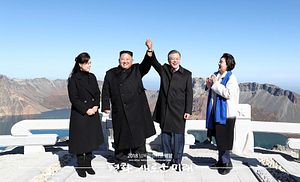Diplomacy between North and South Korea continues apace in 2018, and the just-concluded fifth inter-Korean summit in Pyongyang underlines the remarkable depth and breadth of their engagement.
The most significant outcome of the latest meeting was the signing by their respective defence ministers of a deal to reduce military tension along the boundary separating the two countries. The agreement, which military delegations had been working on for months, included important provisions to manage and lower the pressure in the air, on land and at sea.
In the meantime, South Korean President Moon Jae-in has been true to his word on providing support for North Korean leader Kim Jong-un’s economic transformation plans. Earlier this year, Kim adopted a new “strategic line” for his country in which he prioritised economic development and downplayed his nuclear arsenal.
A military parade earlier this month to celebrate the 70th anniversary of North Korea’s founding underlined this, with several economic floats calling for national development.
Accordingly, the September 19 Pyongyang Declaration agreed by the two leaders includes a promise to “pursue substantial measures to further advance exchanges and cooperation based on the spirit of mutual benefit and shared prosperity”.
The two sides are enthusiastically pushing ahead, even as South Korea’s ability to make good on many of its promises will be limited by the international sanctions in place against the North.
The fifth inter-Korean summit – the third between Moon and Kim this year – also saw the South Korean president serve as more of a direct mediator between the United States and North Korea than before. For Moon, while progress on inter-Korean issues was a critical impetus for the summit, revivifying the flagging U.S.-North Korea diplomatic process was a greater priority in the weeks leading up to his latest encounter with Kim.
Fortunately for Moon, he left Pyongyang with a big win. The Pyongyang Declaration saw Kim offering up more specific concessions on his ballistic missile and nuclear programmes than he had done at either the June 12 summit with U.S. President Donald Trump or his initial meeting with Moon at Panmunjom on April 27.
Unfortunately for the cause of North Korea’s disarmament, the concessions are highly limited in value. The promise to disassemble the ballistic missile engine test stand at Sohae, for example, had already been verbally agreed at the Singapore summit between Trump and Kim. Kim simply extended it to include the nearby satellite launch facility. While that was a welcome development, the language in the declaration suggested that international experts will be permitted only to observe the dismantlement – not inspect or verify what exactly North Korea does to disable the site.
Even with the site disabled, North Korea’s satellite programme could continue. The country’s northeastern satellite test facility, unused since 2009, could be reactivated, for instance. Alternatively, North Korea could transition towards using road-mobile satellite launchers, as China and Israel have done.
Finally, even though North Korea’s well-known Yongbyon nuclear complex makes an appearance in the latest Moon-Kim declaration, Pyongyang has made no promises about the facility. Instead, it may pursue concessions there if the United States follows through on its commitments under the June 12 agreement, including potentially a declaration to end the Korean war.
Whatever the reality of the concessions and their value, they have done the trick for Moon. The White House has responded positively and momentum is now in place to set up a second summit between Trump and Kim. North Korea is, of course, no closer to disarming itself of its nuclear weapons, but the cause of inter-Korean peace has seen great progress.
For regional states, including China, the summit outcome will be welcomed. Beijing has long supported denuclearization of the peninsula, but will be happy for Kim to reduce the profile of his nuclear weapons and pursue economic development in tandem with Moon.
In the meantime, Moon’s path towards a peace treaty on the peninsula brings South Korea closer to a future where its alliance with the United States has to either end or be seriously recalibrated – another bonus for China.
In the end, it is undeniable that what Moon and Kim have achieved on the inter-Korean front – especially military-to-military measures – is greatly significant, but North Korea’s disarmament remains a distant goal. At the very least, Moon’s efforts will prevent an immediate collapse of the U.S.-North Korea process, but Pyongyang and Washington are no closer to forging an understanding on the fundamental questions that divide them.
This article first appeared at the South China Morning Post. It is republished here with kind permission.

































